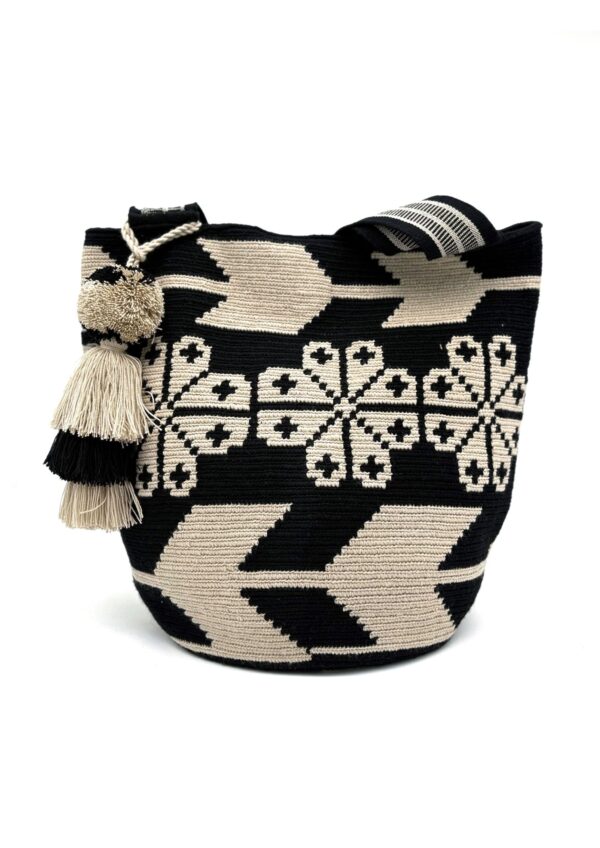From fiber to mochila — a story of patience, purpose, and ancestral skill.
In a world addicted to speed, there is something sacred about waiting. About letting time shape something real. In the Sierra Nevada de Santa Marta, the Kogui and Arhuaca communities don’t just make bags. They carry memories. They carry meaning and they carry time.
Each mochila is handmade over two to three months, using no machines, no shortcuts, and no separation between craft and spirit. This is more than slow fashion. It is ancestral legacy woven into every thread.
1. The Journey Begins: Raw Materials
The process starts with the land. Fique is harvested by hand and chosen with care. The Kogui have an intimate connection with the natural world, and the fibers they use reflect that respect. Nothing is taken in excess. Everything has a purpose.

Fique grows wild in the Sierra Nevada.
The fique plant grows wild in the Sierra Nevada de Santa Marta, its long leaves holding the fibers that will be patiently transformed into thread. It’s one of the most important materials in Kogui mochila-making.
2. Breaking Down the Fique: The Shuno
Fique fibers are broken down using a traditional wooden tool called a schuno. This step is meticulous. One by one, the fibers are separated, softened, and prepared for the long journey ahead. It’s slow. It’s quiet. It’s done with the same rhythm passed down through generations.

A shuno slices through the thick fique leaf, releasing the fibers hidden inside.

With a steady rhythm, the artisan uses a shuno to shred the fique leaf.
3. From Fiber to Thread
After being shredded with a shuno and carefully cleaned, the fique fibers begin their transformation. Once coarse and rigid, they’re softened by hand and pulled, straightened, and prepared to be spun into thread. Each strand carries the rhythm of generations, guided by instinct more than instruction. This is not production. This is transformation from raw plant to purposeful material.

Freshly stripped fique fibers— soft, golden, and ready for the hands that will turn them into heritage.

Using only her fingers, this artisan begins the spinning process — slowly turning fibers into thread. Each motion is quiet, focused, and filled with tradition.
3. Dyeing the Fiber
Some threads are left natural. Others are dyed using plants, roots, or minerals found in the region. Each color holds symbolism: earth, spirit, family, time. This step isn’t just about aesthetics — it’s about identity.

Bundles of hand-dyed fique — each color rooted in nature, each strand ready to become story.
Each color is chosen with intention — often inspired by the land, ancestry, or spiritual symbolism unique to the Kogui worldview. The rich yellow comes from curcuma, a natural root used for generations and the purple comes from Jagina a natural plant found high in the mountains.

Strands of colored fique
The fibers are more than just material. They’re the starting point of stories, passed down from one generation to the next.
3. The Art of Weaving
Francisca, one of the artisans we work with, often weaves with a calm smile. Her hands move with instinct. Each loop, each stitch, carries years of practice and stories from her mother, her grandmother, and those before.

This early stage of the mochila shows the circular base — the beginning of the bag’s form and story. Each round builds upon the last, much like the generations who pass this knowledge down.
The weaving includes the gaza the strap which is often made last. This part takes immense focus and precision. It is both functional and symbolic: the connection between what we carry and how we carry it.

The gaza — or strap — is carefully woven by hand, thread by thread.
4. The Final Mochila
Two or three months later, the mochila is complete. But what you hold is not just a bag. It is time. It is care. It is culture made tangible.

After weeks of weaving, the final stitches come together.
After weeks of work, the mochila is finished. What she holds isn’t just a bag — it’s the memory of every thread, every moment, and every lesson passed down through generations.

Every curve, every color, every stitch in this mochila carries intention. Handmade over months, it’s more than fashion — it’s living history, ready to be carried.

Every mochila carries more than just color — it carries a language of symbols.
Reflection
There are no shortcuts to meaning. When you support Woven Wildly, you’re not just buying a handmade product. You’re honoring a process that refuses to be rushed, a people who choose purpose over profit, and a story that took months to tell.
Call to Action:
Support the hands that preserve heritage. Carry a mochila that carries more than things. Carry legacy.
This story was shared by Woven Wildly — a living collaboration with Indigenous communities of the Sierra Nevada de Santa Marta. We don’t just sell mochilas. We carry culture.
Thank you for reading, for caring, and for helping preserve what matters.

This is what it’s really about — not just what we carry, but who we carry it for. Every mochila sold helps keep these communities strong, self-sustaining, and seen.





This was such a moving and beautifully written insight into the depth behind each mochila. I never realised how much time, care, and spirit is woven into every stage — from harvesting the fique to the final stitch of the gaza. What you’re doing here goes far beyond fashion or commerce. You’re preserving heritage with humility and letting the craft speak for itself. Thank you for inviting us into this sacred process — it’s a powerful reminder that the most meaningful things in life are never made in haste.